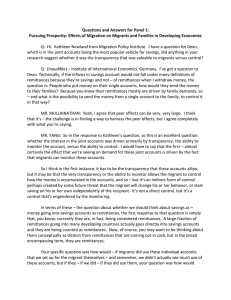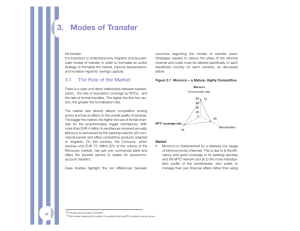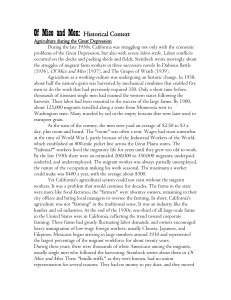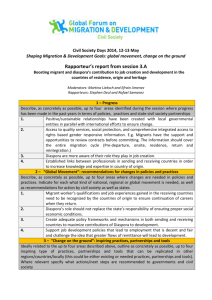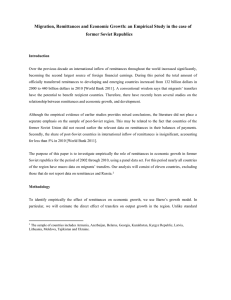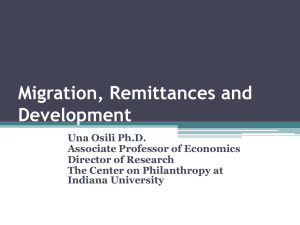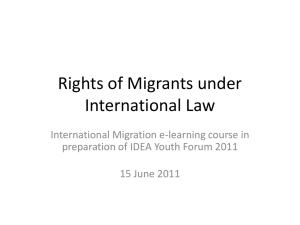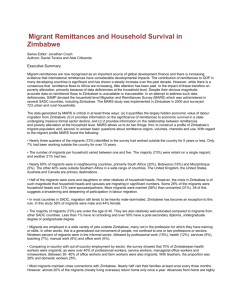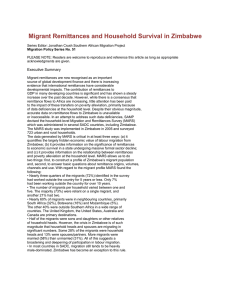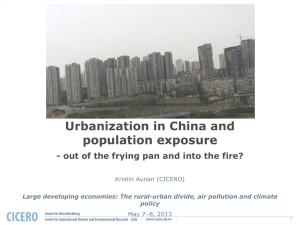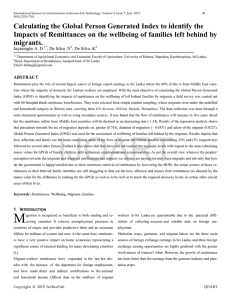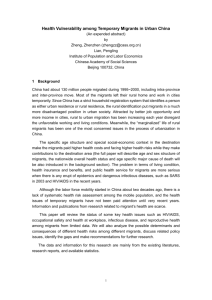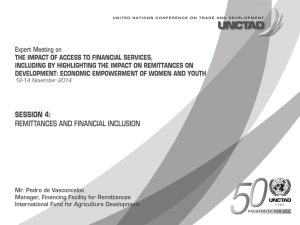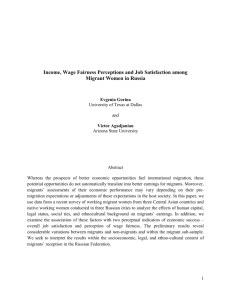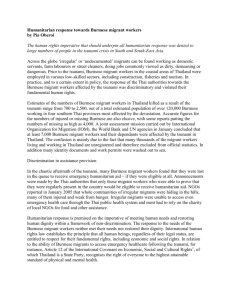Thebe-omalayisha-presentation
advertisement
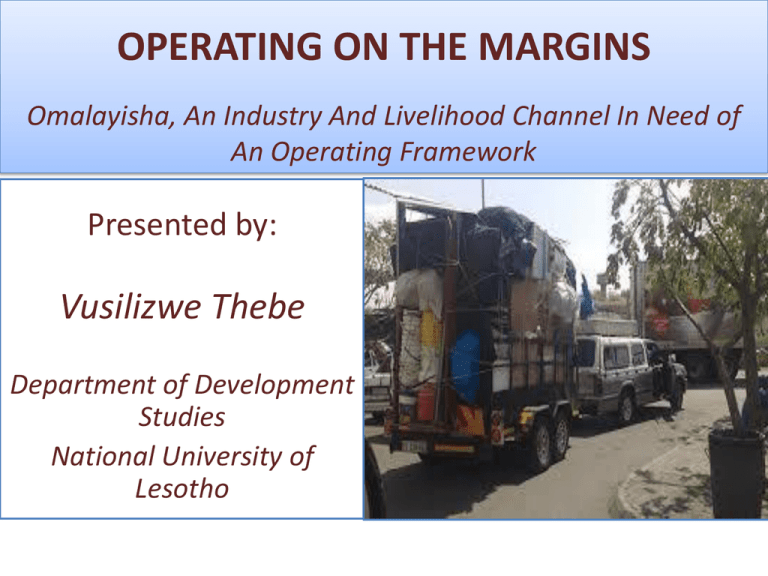
OPERATING ON THE MARGINS Omalayisha, An Industry And Livelihood Channel In Need of An Operating Framework Presented by: Vusilizwe Thebe Department of Development Studies National University of Lesotho Intro. Article focuses on cross-border goods courier industry and movement of remittances from RSA to Zim. Remittances and their movement are key issues in worker-peasant or migrant labor communities • Relocation of urban-based livelihoods fro Byo to Jhb • Cross-border movement of remittances grew into big business & industry. • Industry dominated by South African based Ndebele migrants (omalayisha). • Omalayisha had taken over the role of the rural bus service. • They were central role players in rural economy. Intro. Cont. The rapid ‘same day or overnight’ service bridged the geographical gap between Johannesburg and even remote areas of Matabeleland, and by moving people, goods and cash remittances, it provided an apparently sustainable and seamless exchange between labour and its earnings. Omalayisha were a permanent feature on South African roads and despite visible police presence and evidence of harassment by traffic and law enforcement agencies, they continued to persevere. Intro. Cont. Certain developments after year 2009 in both Zimbabwe and South Africa: • Dolarisation in Zimbabwe after GNU. • South Africa’s policy of good neighborliness (ZDP). • Threatened the core of industry business. • Many cynics saw the end of the industry. Intr. Cont. I set out to understand the future of the industry in the context of new developments. To do this I needed to understand: • The industry & its background • Operations & challenges • Where they seat among the Ndebele migrant community Intro. Cont. Paper offers a unique perspective on cross-border transporters. Rather than criminalizing their activities it views them as: • A necessary and indispensable industry and channel of remittances for worker-peasantries. • Its existence is tied to the changed character of urban-based livelihoods in Zimbabwe in in general and Mat. in particular. • It needs a framework that will legitimize and guide operations but maintain the informality. Methodology Selected reading of literature and reviews of studies on Zimbabwe migration Extended study of omalayisha & clients between 2007 and 2013 Study divided into two: • 2007 – 2009 – Study detailed origins & significance of omalayisha. • 2010 – 2013 – follow-up study. • Extended studies also drew accounts from 147 migrant clients. Origins of the industry A Johannesburg/rural Matabeleland South Service: Provided service to migrants community, from the Johannesburg inner-city to Soweto, and expanded to Pretoria and surrounding areas like Diepslot. Started as informal, part-time activity by migrants who owned cars. Omalayisha transformed to full-time and business activity with increased migration into South African cities in late 1990s . Community orientation: served migrants from same communities (friends, neighbors, kin) Origins cont. With the extension of service to Bulawayo, the industry lost its community orientation. • More migrant entrepreneurs entered the industry Post-2000, it spread to most parts of Zimbabwe. Omalayisha were transporting anything & everything across borders at a price. People smuggling became core and lucrative business. • Both transporters and migrants saw nothing wrong with such activities (omalayisha offered a service to a client base and the client needed the service and were willing to pay for the service). How the industry operates? Too informal with easy of entry and exit: • No umbrella body/association • No operation permits • Anyone with car, can hire trailer & find clients to serve • Convenient door-to-door/home-to-home service • Cash, prepaid or cash on delivery terms • Use of bribes (strive by operating on the margin) Effects of new developments • Return of goods on shop shelves led to decline on outbound trips. • New immigration policy closed the lucrative people smuggling function. • Fewer outbound trips: Average one in two months Transportation of funeral parties Made up for loss of business during holidays Effects cont. Demand for service to rural south-western Mat. remained stable: • Rural migrants remitted food and other items that were available locally monthly due to convenience • Use omalayisha as convenient mode of transport on journeys home on holidays, vacations, emergencies Urban operators gained access to rural communities by employing drivers from such communities. New demands Facilitating movement of children under 17: • Assisting migrant parents with movement of children during school holidays • Became a core function after immigration changes on children under 17 Assisting mothers with infants: • Migrant mothers enlist services of transporters to take young children to parents Deeply embedded • Like the rural bus service, the industry has become a permanent feature in semi-proletarian Mat. society. • Immigration policy strengthened semiproletarianisation. • Deepened the omalayisha enculturation of • Parallels between historical movement of remittances to rural areas and the contemporary malayisha system Problem areas Operate on the margins of law • Use of dilapidated, unroadworthy vehicles. • Lack of an operating framework. • Issues of legitimacy (from officials) • Breakdowns and a challenge to other road users. Promote corruption by bribing traffic and border officials for access routes/cold drink fee Operating framework Omalayisha now operate modern and roadworthy fleets But industry needs a regulatory framework: • To guide operations • To protect transporters from harassment by traffic & law enforcement agencies • For the industry to contribute to South African economy But maintain the informal nature of the industry, which makes the industry unique and convenient for migrants END
